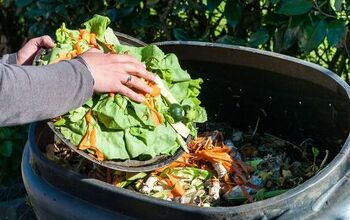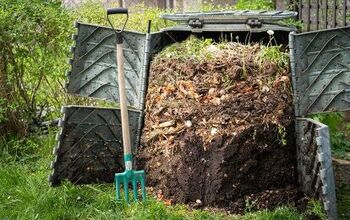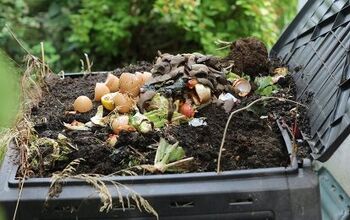How To Store Compost In The Winter For Later Use

Are you one of the countless homeowners who have been torn about what to do with your compost pile for the winter? This is a common dilemma for many homeowners who don’t want to let their compost go to waste as temperatures plummet. Understandably, many homeowners struggle with how to store compost in the winter for later use.
The best way to store compost in the winter for later use is to put it in plastic totes. Drill holes in the lid so that your compost pile can still get air and moisture, or else the bacteria may die. Alternatively, you can put your compost in a compost container or garbage can and leave it outside as it will continue to break down in the winter.
You can also put your compost in a plastic container and keep it in your basement or crawl space. It is a common misconception that compost piles don’t progress during the winter. While the progress slows down, it doesn’t cease altogether. Follow along as we explore how to store compost in the winter for later use.
Where Should Compost Be Stored In The Winter?
You can store compost in the winter in everything from plastic totes to garbage cans. Compost is less sensitive to cold temperatures than many homeowners think. However, it’s still worthwhile to take any possible precaution to ensure that your compost pile is in good shape by the time temperatures warm up. Let’s take a look at how to store compost in the winter for later use.
Plastic Tote
Store your compost in a plastic tote during the winter. That way, you can get your compost out of the way while keeping it intact. Simply transfer your compost to a plastic tote or two and drill a few holes in the lid.
As an alternative, you can leave one corner of the lid slightly open to let air in. This will prevent your compost from going bad. It will also prevent negative bacterial growth, mold, and mildew.
Compost Container
If you don’t already have a compost container, then the winter is a perfect time to get one. This is the best way to keep your compost pile going strong during the winter. It won’t make progress as it would during the spring and summer because of the temperature, but it will still work.
You may want to insulate your compost container with paper and or plastic trash bags. This will prevent the process from slowing down too much because the compost won’t get too cold.
Garbage Can
A metal garbage can may be all that you need to store your compost for the winter. Trash cans essentially work the same way as standard compost containers. You can easily fill a garbage can with your compost and it will go on uninterrupted.
This works whether you want to keep your compost going during the winter or save it for later. Insulate the trash can with bags and black paint to help retain as much warmth as possible. This will ensure that your compost will be thriving by the time the spring and summer roll around.
Create A Large Pile
If you are unable to transport your compost to another location, you can simply fortify the existing pile. Insulate your compost pile with more dirt, coffee grounds, plant trimmings, and vegetables. Your compost will stay warmer for longer and retain heat if you make the pile big enough.
This will also come in handy when the temperatures rise. It won’t take as long for your compost pile to return to its normal process when it warms up if you fortify the pile in the winter.
Crawl Space
If you are lucky enough to have a crawl space, then you have a great indoor location to store compost for later use. You won’t have to worry about odors in most cases if you put your compost in the crawl space. Of course, you will need to put the compost in a container before you do this.
Either put your compost in a plastic tote or a garbage can before you put it in the crawl space. Make sure to poke at least 2-4 holes in the lid of either container. You can also store compost in your basement if you put it in a container with holes in the lid.
What Happens To A Compost Pile In The Winter?
Your compost pile will continue to break down in the winter. However, it will happen at a much slower rate than it would during the spring and summer. The bacteria in your compost pile can survive the winter in many cases.
Insulating your compost pile is the best way to ensure that it will continue to break down during the winter. You can continue to add discarded food to your compost pile during the winter. Try to move your compost pile to an area with as much sunlight as possible so that it stays healthy when it’s cold.
It also helps if your compost pile can get some moisture. A dry compost pile isn’t as active, especially during the winter.
Should I Cover My Compost Pile With A Tarp In The Winter?
You should not cover your compost pile with a tarp in the winter. This will restrict the sunlight and will make your compost pile break down even slower. It can also prevent your compost pile from getting the moisture that it needs and it may dry out.
However, you should poke holes in the tarp if you insist on putting one over your compost pile. Look for a black tarp if possible to insulate your compost pile so that it retains heat. Otherwise, it’s better to leave the pile open to the sun or in a container with many holes in the lid to let light in.
Summing It Up
The best way to store compost in the winter is to put it in a compost container or garbage can. Make sure to poke holes in the lid of your garbage can if you use this method. This will ensure that your compost gets enough air and moisture.
It also helps to put your compost in a plastic tote with holes in the lid. That way, you can store the compost in your basement or crawl space and bring it back outside in the spring or summer. You can also simply add to the pile and leave your compost outside during the winter. It will continue to work and break down, albeit at a slower rate because of the cold temperatures.
Related Guides

Nick Durante is a professional writer with a primary focus on home improvement. When he is not writing about home improvement or taking on projects around the house, he likes to read and create art. He is always looking towards the newest trends in home improvement.
More by Nick Durante



























